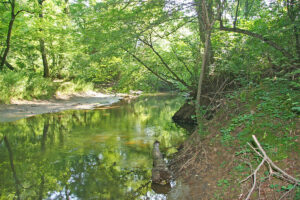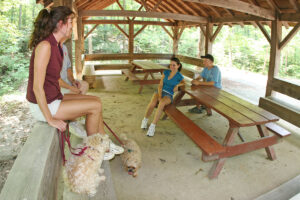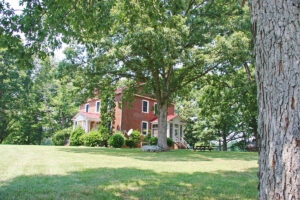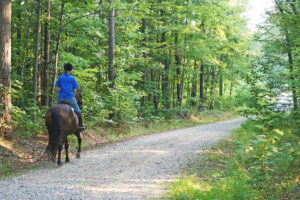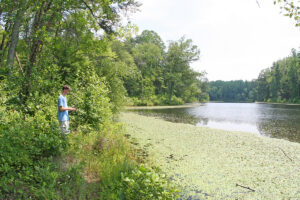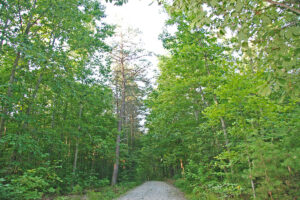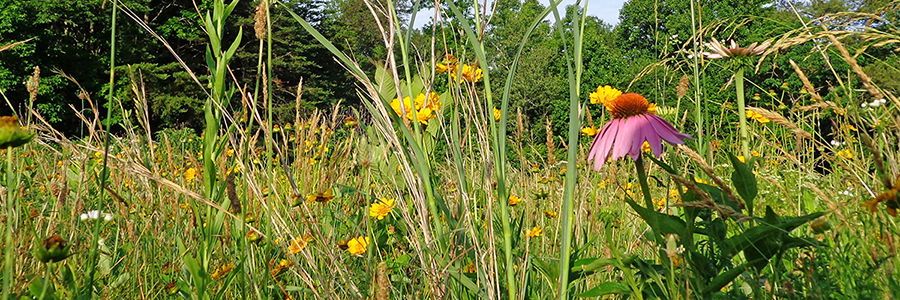
Overview
Cumberland State Forest is Virginia’s second largest at 16,154 acres. Most of the forest is in Cumberland County, with a small portion in Buckingham County. It has a diversity of pine and hardwood forest types, with land ranging from flat bottomlands to moderate slopes. The forest is managed for multiple uses: timber, wildlife, recreation, water quality, biodiversity, research, and demonstration.
Approximately 121 miles of waterways flow through or adjacent to the forest, including more than 15 miles of the Willis River, 26 miles of perennial streams, 47 miles of intermittent streams, and 32 miles of ephemeral streams. The property contains four small lakes; Bonbrook, Arrowhead, Winston, and Oak Hill. Cumberland State Forest contains several vernal pools. Most of these seasonally-flooded wetlands are less than ¼ acre in size. They are typically largest during wet, winter months and completely dry during the summer.
Approximately 100 years ago, most of this area was either active or abandoned farmland. Evidence from this past land use remains visible today. Rock piles can be found scattered across the forest where farmers cleared them to cultivate the land. Hills and furrows created by plowing can still be found on the forest floor of many timber stands.
The Cumberland State Forest Office, also known as the “Trenton” house, is listed in the Virginia Department of Historic Resources inventory. The main house was constructed by Dr. John Trent in 1815. The “Oak Hill “ house, located on Oak Hill Forest Road, was built by the Thornton family around 1810.
Bear Creek Lake State Park lies within the boundaries of the state forest.
At a Glance
Access Status: Open to the Public
Hours: Open daily from dawn until dusk
Physical Address:
Latitude/Longitude:
37° 31’ 38.5”, -78° 17’ 07.3″
Office: 751 Oak Hill Road, Cumberland, VA 23040
Parking/Access: Access from many points
Directions to office and the parking area outside the entrance gate – Take Route 60 west from Cumberland Courthouse, turn north on Forest View Road and follow until it ends at the intersection of Oak Hill Road. The driveway for the office is directly across the intersection from Forest View Road. Parking is allowed at the office for office visits only. Please park outside the entrance gate for all recreational activities.
Other parking lots for trail usage can be found on Warner Forest Road, Toll Gate Forest Road, and Bear Creek Forest Road.
The forest has four lakes and each contains a parking lot or designated parking area.
Open spaces at the entrance of gated forest roads and large pull off areas are scattered across the forest and available for parking; do not block the gates.
Restroom Facilities: None
Visitors are asked to adopt a “leave-no-trace” ethic when visiting the forest, as there are no restrooms or trash cans on the forest itself.
Other Facilities: 1 picnic shelter is located at Winston Lake
Seasonal Closures: Sections of trails and forest roads may close occasionally during timber harvest operations.
VDOF recommends that all forest visitors wear blaze orange or pink during hunting seasons.
Cumberland became a state forest in 1939, as a result of the Bankhead-Jones Farm Tenant Act, a federal land-buying program of the Great Depression. At that time, the land comprising Cumberland State Forest was mostly a combination of active and abandoned farmland. There was very little timber of size and the land was highly eroded from farming practices of the past. The Commonwealth of Virginia originally leased the property from the federal government, which deeded it to the Commonwealth in 1954.
Cumberland State Forest is roughly 34.1% upland hardwood, 1.4% bottomland hardwood, 10.8% pine-hardwood, 5.5% Virginia pine, 47.4% loblolly pine, and 0.8% other forest types. The land ranges from bottomland to sloped uplands. The soils cover a wide range of productivity levels and moisture contents; some areas are relatively rocky, while others are not. This combination of topography and soils, along with the added benefit of timber management, creates a variety of forest types, timber size classes, timber form, and timber ages. A short hike from one ridge across a bottom to another ridge often reveals several different stands with a multitude of species and sizes. A good example of the diversity at Cumberland State Forest would be in the oak species that are here. Blackjack oak, chestnut oak, post oak, scarlet oak, black oak, southern red oak, white oak, northern red oak, willow oak, and pin oak are all present.
The purpose of the State Forest System is to provide working demonstrations of forests that conserve biological diversity, maintain or improve the productive capacity of the forest, maintain the health and vigor of the forest and it’s watershed, contribute to carbon cycles, consider socio-economic benefits, and protect soil and water quality.
The overall management scheme for Cumberland State forest revolves around the management of its timber, with long rotations. The pine forest types are typically grown until they reach sawtimber size, if not full maturity. The hardwood forest types are typically grown until maturity.
Sustainable timber harvesting is common practice at Cumberland State Forest. It allows the State Forest System to generate income necessary for maintenance and improvement operations while ensuring that the forest resource will be available for future generations to enjoy. Furthermore, controlling the location, timing, and type of harvest allows management to improve wildlife habitat, increase age and size diversity throughout the forest, and create a variety of viewsheds for recreational users.
While timber harvesting is important for achieving many goals on Cumberland State Forest, approximately one fourth of the Cumberland acreage is designated as “non-commercial”, meaning they are not to be harvested because they provide other benefits or harvesting could have a negative impact on the site. Much of this area includes streamside management zones and buffers around lakes and vernal pools. These areas are left alone to provide soil protection and filter runoff before it reaches waterways. These areas produce a variety of mast for wildlife food and make excellent wildlife travel corridors. Other areas, such as wetlands, have been removed from timber production for different reasons. Wetlands are home to a variety of unique plant and animal species that are not typically found on other sites. Furthermore, equipment operation in these areas would likely have a negative impact on soils, fauna, and flora.
Cumberland State Forest contains several hundred acres of wetlands along the Willis River and some of its tributaries. There are also four natural areas located on Cumberland State Forest. These areas are left undisturbed to carry out the process of natural succession. A natural area exists in each of the following conditions; reverted field (cedar, Virginia pine), mature upland hardwood, mature bottomland hardwood, and a 255-year old post oak stand.
The combination of timber management and harvesting in many areas and a “hands-off” approach in other areas greatly contributes to the diversity of the forest. It allows Cumberland State Forest to meet the core principles identified for the state forest system while generating income and providing recreational opportunity.
Recreational uses of the Cumberland State Forest include hunting, fishing, trapping, hiking, mountain biking, horseback riding, and wildlife watching. One of the highlights of the forest is the 15.8 mile Cumberland Multi-Use Trail.
Visitors are asked to adopt a “leave-no-trace” ethic when visiting the forest, as there are no restrooms or trash cans on the forest itself.
ATV/ORV use, camping, and swimming are prohibited on all State Forests.
A State Forest Use Permit* is required for individuals aged 16 and older to hunt, fish, trap, horseback ride, or mountain bike on state forest lands. The permit can be purchased online or where hunting licenses are sold.
Trails and Roads
- 34 miles of forest trails (no vehicles), including Cumberland Multi-Use Trail (15.7 miles), Willis River Trail (14.8 miles), and Coffey Trail (3.3 miles)
- 23.9. miles of forest roads (vehicles allowed)
- 67.1 miles of gated forest roads (no vehicles)
- No driving past forest gates.
Hiking
Hiking is permitted on all forest roads, Cumberland Multi-Use Trail, Willis River Trail, and Coffey Trail.
Mountain Biking
Mountain biking is permitted on all forest roads and the Cumberland Multi-Use Trail.
Horseback Riding
Horseback riding is permitted on all forest roads and the Cumberland Multi-Use Trail.
State law requires that visitors carry a copy of a negative Coggins test report with each horse on state lands.
Fishing and Boating
Only non-motorized boats are allowed on state forest waterways.
Canoeing and kayaking are allowed in Bonbrook, Arrowhead, Winston, and Oak Hill Lakes and in the Willis River. Note that the Willis River is shallow in places and often blocked by fallen trees. Canoers and kayakers can expect to exit and port their watercraft in multiple locations.
Fishing is permitted in Bonbrook, Arrowhead, Winston, and Oak Hill Lakes as well as the Willis River in accordance with state fishing regulations. Both a State Forest Use Permit and Virginia fishing license are required.
Hunting and Trapping
Hunting and trapping are permitted with a valid State Forest Use Permit and valid hunting license in accordance with state regulations. Note that some regulations may be different than on private land, so check Virginia Department of Wildlife Resources Hunting Regulations for specific state forest details.
Refer to the Hunter’s Map before hunting on Cumberland State Forest. Four areas of the forest have been identified as safety zones where no hunting is allowed. Hunters and trappers may park anywhere they can get off the road without causing damage to the property. Please do not block gated roads when parking as access may be needed for management operations or in the event of an emergency.
Other Recreational Opportunities
One picnic shelter is located at Winston Lake.
Passive recreational opportunities, such as wildlife watching and nature photography, are available.
- Self-learning opportunities are available.
- Formal education programs are available upon request.
Tours of forest management activities for university classes and other organized groups may be arranged upon request.
Learn how to use a GPS, topographical maps, or aerial imagery as you hike across the landscape. Use identification guides to learn how to identify various trees, wildlife, wildflowers, fungi, and herbaceous plants.
The State Forest demonstrates a variety of forest management practices. These include harvesting techniques, the implementation of Best Management Practices (BMP’s), tree planting, and the management of natural stands. We encourage our visitors to view these sites and gain an understanding of why and how they were done, and the benefits they provide. Forestry and wildlife tours are typically held about once each year in spring or fall. These tours cover a variety of timber and wildlife practices from the perspective of professional foresters and wildlife biologists.
For more information or questions, e-mail us or use our contact form.
State Forest Main Office
Located at Cumberland State Forest
751 Oak Hill Road, Cumberland, VA 23040-2511
E-mail | (804) 492-4121
Local Contact
Shannon Lewis, Forester
751 Oak Hill Road, Cumberland, VA 23040-2511
E-mail | (804) 492-4121

